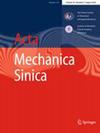A novel quasi-zero stiffness isolator with designable stiffness using cam-roller-spring-rod mechanism
Abstract
Quasi-zero stiffness (QZS) isolators have received considerable attention over the past years due to their outstanding vibration isolation performance in low-frequency bands. However, traditional mechanisms for achieving QZS suffer from low stiffness regions and significant nonlinear restoring forces with hardening characteristics, often struggling to withstand excitations with high amplitude. This paper presents a novel QZS vibration isolator that utilizes a more compact spring-rod mechanism (SRM) to provide primary negative stiffness. The nonlinearity of SRM is adjustable via altering the raceway of its spring-rod end, along with the compensatory force provided by the cam-roller mechanism so as to avoid complex nonlinear behaviors. The absolute zero stiffness can be achieved by a well-designed raceway curve with a concise mathematical expression. The nonlinear stiffness with softening properties can also be achieved by parameter adjustment. The study begins with the force-displacement relationship of the integrated mechanism first, followed by the design theory of the cam profile. The dynamic response and absolute displacement transmissibility of the isolation system are obtained based on the harmonic balance method. The experimental results show that the proposed vibration isolator maintains relatively low-dynamic stiffness even under non-ideal conditions, and exhibits enhanced vibration isolation performance compared to the corresponding linear isolator.

 求助内容:
求助内容: 应助结果提醒方式:
应助结果提醒方式:


